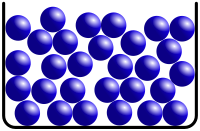
Photo from wikipedia
In the IR spectra of silica and silicate glasses, the shifts of the maximum intensity position of the νSi-O-Si,as band upon heating or applying mechanical stress could be attributed to… Click to show full abstract
In the IR spectra of silica and silicate glasses, the shifts of the maximum intensity position of the νSi-O-Si,as band upon heating or applying mechanical stress could be attributed to changes in the distribution of bond parameters such as bond length and bond angle. Upon heating, isotropic expansion occurs and the density changes; upon applying mechanical stress, anisotropic strain is induced and a significant change in the Si-O-Si bond angle is observed. From molecular dynamics simulations of silica glasses, we show that the peak position shift correlates better with the asymmetric change in the Si-O bond length distribution, rather than the Si-O-Si bridge angle, the O-Si-O tetrahedral angle, or the density change. This new finding provides an insight into how and why the νSi-O-Si,as IR peak of soda lime silica (SLS) glass shifts upon chemical strengthening via ion exchange and thermal tempering. This article is protected by copyright. All rights reserved.
Journal Title: Journal of the American Ceramic Society
Year Published: 2018
Link to full text (if available)
Share on Social Media: Sign Up to like & get
recommendations!